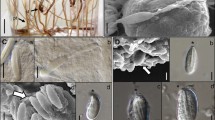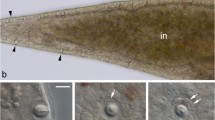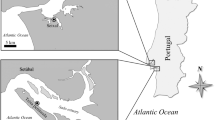Abstract
Nematocytes’ discharge is triggered to perform both defense and predation strategies in cnidarians and occurs under chemico-physical stimulation. In this study, different compounds such as amino acids and proteins (mucin, albumin, poly-l-lysine, trypsin), sugars and N-acetylate sugars (N-acetyl neuraminic acid, N-acetyl galactosamine, sucrose, glucose, agarose and trehalose), nucleotides (ATP and cAMP), were tested as chemosensitizers of nematocyte discharge in the oral arms of the scyphozoan Pelagia noctiluca, particularly abundant in the Strait of Messina (Italy). Excised oral arms were submitted to a combined chemico-physical stimulation by treatment with different compounds followed by mechanical stimulation by a non-vibrating test probe. Discharge induced by a chemico-physical stimulation was more significant than that obtained after mechanical stimulation alone. A chemosensitizing mechanism, with a dose-dependent effect, was observed after treatment with sugars, amino compounds such as glutathione, nucleotides and mucin, according to that already seen in sea anemones. Such findings suggest that, though Anthozoa and Scyphozoa exhibit different divergence times during the evolutionary process, the discharge activation exhibits common features, probably derived from their last common ancestor.







Similar content being viewed by others
Abbreviations
- NANA:
-
N-acetyl neuraminic acid
- NAGA:
-
N-acetyl galactosamine
- ATP:
-
Adenosine-5′-triphosphate
- cAMP:
-
Cyclic adenosine monophosphate
- GSH:
-
Glutathione
- ASW:
-
Artificial seawater
- NMDA:
-
N-methyl-d-aspartate
- RNA:
-
Ribonucleic acid
References
Anderson PAV, Bouchard C (2009) The regulation of cnidocyte discharge. Toxicon 54:1046–1053
Bellis SL, Laux DC, Rhoads DE (1994) Affinity purification of Hydra glutathione binding proteins. FEBS Lett 354:320–324
Collins AG, Schuchert P, Marques AC, Jankowski T, Medina M, Schierwater B (2006) Medusozoa phylogeny and character evolution clarified by new large and small subunit rDNA data and an assessment of the utility of phylogenetic mixture models. Syst Biol 55:97–115
Ewer RF (1947) On the functions and mode of action of the nematocysts of hydra. Proc Soc Zool 117:365–376
Fautin DG, Mariscal RN (1991) Cnidaria: Anthozoa. In: Harrison WF, Westfall JA (eds) Microscopic anatomy of invertebrates, vol 2. Wiley-Liss, New York, pp 267–358
Govindarajan A, Halanych K, Cunningham C (2005) Mitochondrial evolution and phylogeography in the hydrozoans Obelia geniculata (Cnidaria). Mar Biol 146:213–222
Greenwood PG, Garry K, Hunter A, Jennings M (2004) Adaptable defense: a nudibranch mucus inhibits nematocyst discharge and changes with prey type. Biol Bull 206:113–120
Grosvenor W, Kass-Simon G (1987) Feeding behavior in hydra. I. Effects of Artemia homogenate on nematocyst discharge. Biol Bull 173:527–538
Holstein T, Tardent P (1984) An ultrahigh-speed analysis of exocytosis: nematocyst discharge. Sciences 223:830–833
Kass-Simon G, Pierobon P (2007) Cnidarian chemical neurotransmission, an updated overview. Comp Biochem Physiol A 146:9–25
La Spada G, Biundo T, Nardella R, Meli S (1999) Regulatory volume decrease in nematocytes isolated from acontia of Aiptasia diaphana. Cell Mol Biol 45:249–258
La Spada G, Marino A, Sorrenti G, Albiero F (2001) Morphological characteristics by SEM observations and regulatory volume decrease (RVD) of tentacular nematocytes isolated by heat dissociation from Aiptasia diaphana (Cnidaria: Anthozoa). Cell Mol Biol 47:OL105–OL114
La Spada G, Sorrenti G, Soffli A, Montaleone B, Marino A, Musci G (2002) Thiol-induced discharge of acontial nematocytes. Comp Biochem Physiol B 132:367–373
Lubbock R (1979) Chemical recognition and nematocytes excitation in a sea anemone. J Exp Biol 83:283–292
Marchini B, De Nuccio L, Mazzei M, Mariottini GL (2004) A fast centrifuge method for nematocysts isolation from Pelagia noctiluca Forskal (Cnidaria: Scyphozoa). Riv Biol Biol Forum 97:505–516
Marino A, La Spada G (2004) Regulatory volume increase in nematocytes isolated from acontia of Aiptasia diaphana (Cnidaria, Anthozoa). Cell Mol Biol 50:OL533–OL542
Marino A, Valveri V, Crupi R, Muià C, Rizzo G, Musci G, La Spada G (2004) Cytotoxicity of toxins from nematocysts of Aiptasia mutabilis. Comp Biochem Physiol A 139:295–301
Marino A, Morabito R, Pizzata T, La Spada G (2008) Effect of various factors on Pelagia noctiluca (Cnidaria, Scyphozoa) crude venom-induced haemolysis. Comp Biochem Physiol part A 151:144–149
Marino A, Morabito R, La Spada G (2009) Factors altering the haemolytic power of crude venom from Aiptasia mutabilis (Anthozoa) nematocysts. Comp Biochem Physiol A 152:418–422
Marino A, Morabito R, La Spada G, Adragna NC, Lauf PK (2010) Mechanisms of hyposmotic volume regulation in isolated nematocytes of the anthozoan Aiptasia diaphana. Cell Physiol Biochem 26:209–218
Mauch S, Elliott J (1997) Protection of the nudibranch Aeolidia papillosa from nematocyst discharge of the sea anemone Anthopleura elegantissima. Veliger 40:148–151
Mire-Thibodeaux P, Nasse J (2002) Hair bundle motility induced by chemoreceptors in anemones. Hear Res 163:111–120
Mire-Thibodeaux P, Watson GM (1997) Mechanotransduction of hair bundles arising from multicellular complexes in anemones. Hearing Res 113:224–234
Ozacmak VH, Thorington GU, Fletcher WH, Hessinger DA (2001) N-Acetylneuraminic acid (NANA) stimulates in situ cyclic AMP production in tentacles of sea anemone (Aiptasia pallida): possible role in chemosensitization of nematocyst discharge. J Exp Biol 204:2011–2020
Ozbeck S, Balasubramanian PG, Holstein TW (2009) Cnidocyst structure and the biomechanics of discharge. Toxicon 54:1038–1045
Park E, Hwang DS, Lee JS, Song JI, Seo TK, Won YJ (2012) Estimation of divergence times in cnidarians evolution based on mitochondrial protein-coding genes and the fossil record. Mol Phylogenet Evol 62(1):329–345
Rottini-Sandrini L, Avian L (1989) Feeding mechanism of Pelagia noctiluca (Scyphozoa: Semaeostomeae); laboratory and open sea observations. Mar Biol 102:49–55
Salleo A, Musci G, Barra P, Calabrese L (1996) The discharge mechanism of acontial nematocytes involves the release of nitric oxide. J Exp Biol 199:1261–1267
Santoro G, Salleo A (1991a) Cell to cell transmission in the activation in situ of nematocytes in acontia of Calliactis parasitica. Experientia 47:701–703
Santoro G, Salleo A (1991b) The discharge in situ of nematocysts of the acontia of Aiptasia mutabilis is a Ca2+-induced response. J Exp Biol 156:173–185
Scappaticci AA, Kass-Simon G (2008) NMDA and GABAB receptors are involved in controlling nematocyst discharge in Hydra. Comp Biochem Physiol A 150:415–422
Scappaticci AA, Kahn F, Kass-Simon G (2010) Nematocyst discharge in Hydra vulgaris: differential responses of desmonemes and stenoteles to mechanical and chemical stimulation. Comp Biochem Physiol A 1157(2):184–191
Technau U, Rudd S, Maxwell P, Gordon PMK, Saina M, Grasso LC, Hayward DC, Sensen CW, Saint R, Holstein TW, Ball EE, Miller DJ (2005) Maintenance of ancestral complexity and non-metazoan genes in two basal cnidarians. Trends Genet 21:633–639
Thorington GU, Hessinger DA (1988) Control of cnide discharge: I. Evidence for two classes of chemoreceptor. Biol Bull Mar Biol Lab Woods Hole 174:163–171
Thorington GU, Hessinger DA (1996) Efferent mechanisms of discharging cnidae: I. Measurements of intrinsic adherence of cnidae discharged from tentacles of the sea anemone, Aiptasia pallida. Biol Bull 190:125–138
Tibballs J (2006) Australian venomous jellyfish, envenomation syndromes, toxins and therapy. Toxicon 48:830–859
Venturini G (1987) The Hydra GSH receptor. Pharmacological and radioligand binding studies. Comp Biochem Physiol C87:321–324
Watson GM, Hessinger DA (1989) Cnidocyte mechanoreceptors are tuned to the movements of swimming prey by chemoreceptors. Science 243:1589–1591
Watson GM, Hessinger DA (1992) Receptors for N-acetylated sugars may stimulate adenylate cyclase to sensitize and tune mechanoreceptors involved in triggering nematocysts discharge. Exp Cell Res 198:8–16
Watson GM, Mire P (2004) Dynamic tuning of hair bundle mechanoreceptors in a sea anemone during predation. Developments in Hydrobiology, vol 178 (Part II). pp 123–128
Watson GM, Roberts J (1995) Chemoreceptor-mediated polymerization ad depolymerization of actin in hair bundles of sea anemones. Cell Mot Cytoskel 30:208–220
Westfall JA (2004) Neural pathways and innervation of cnidocytes in tentacles of sea anemones. Hydrobiologia 530(531):117–121
Author information
Authors and Affiliations
Corresponding author
Rights and permissions
About this article
Cite this article
Morabito, R., Marino, A. & La Spada, G. Nematocytes’ activation in Pelagia noctiluca (Cnidaria, Scyphozoa) oral arms. J Comp Physiol A 198, 419–426 (2012). https://doi.org/10.1007/s00359-012-0720-7
Received:
Revised:
Accepted:
Published:
Issue Date:
DOI: https://doi.org/10.1007/s00359-012-0720-7




